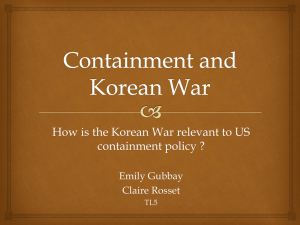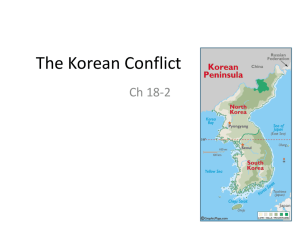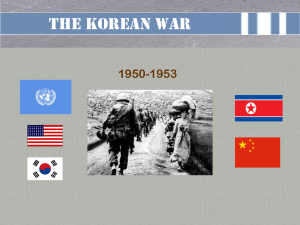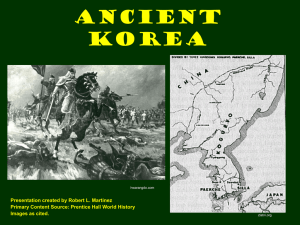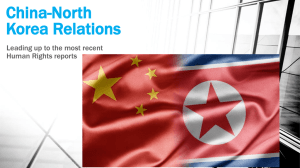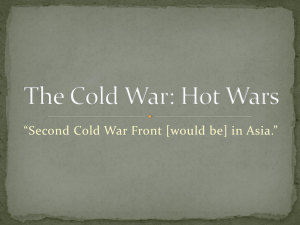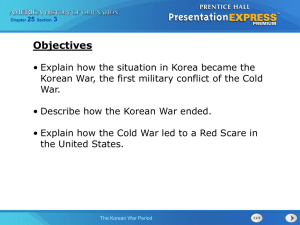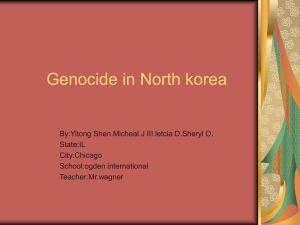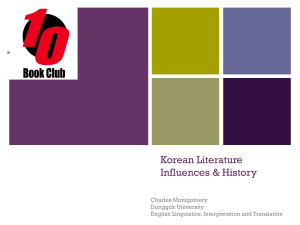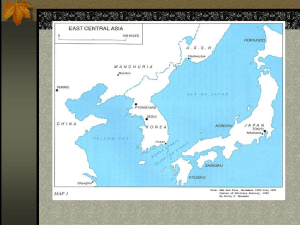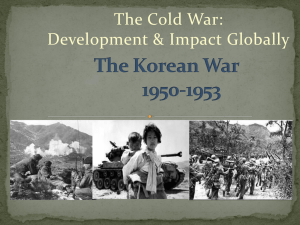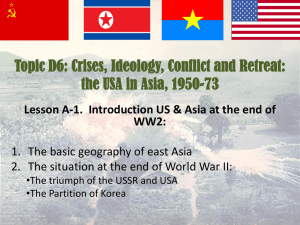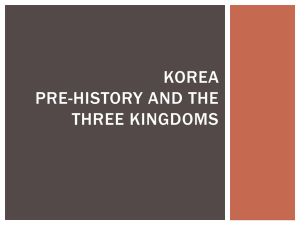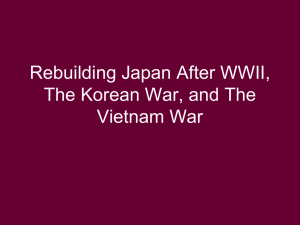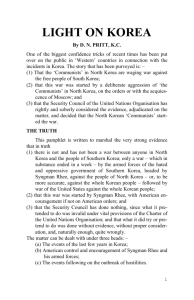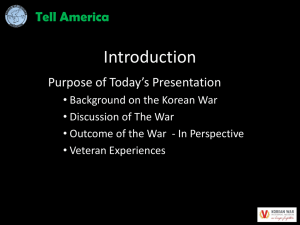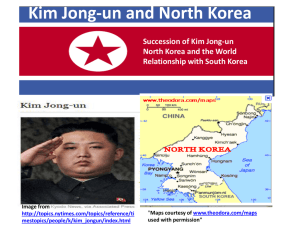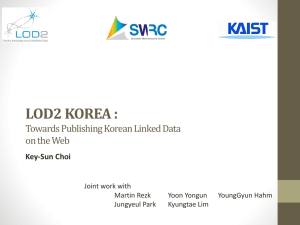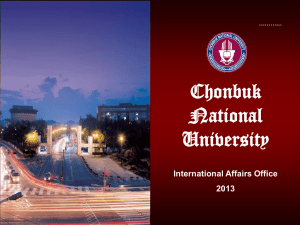The ROK after the war: Syngman Rhee And Park Chung Hee
advertisement
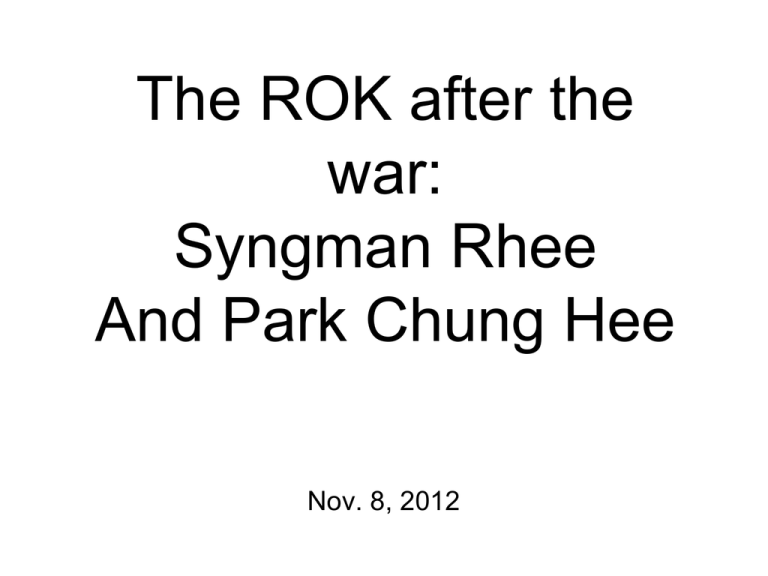
The ROK after the war: Syngman Rhee And Park Chung Hee Nov. 8, 2012 Review • Why did North Korea take the Communist route to modernization? • How did Kim Il Sung manage to hold onto power in the north after he lost the Korean War? • How did North Korea manage to grow its economy faster than the South Korean economy for the first two decades after the Korean War? • What is the guiding ideology of North Korea? Corporatism in the DPRK What is corporatism: A political philosophy emphasizing hierarchy, family, and organic connections (Just as a family is not a democratic institution, a corporate polity is not democratic, either.) Fascism is one form of corporatism. In North Korea, the nation is one big family, led by the dead grandfather his fatherly son, and his loyal grandson. In a corporate polity, everyone has to accept their assigned role (assigned by the“head of the family.”) Rhee’s Post-War Policies Economy grew only a little faster than population growth. Inflation was a serious problem, though. There was little internal surplus for investment Rhee’s policies: import substitution, keep Korean currency artificially high, keep agricultural prices low. Political connections determined access to economic resources. One sign of hope: Education become more available. Rhee’s authoritarianism Treated the constitution with disdain (Sources, pp. 383-4) Also election results could not be trusted. Used National Security Law against all sorts of opponents. (Cho Pongam, a former cabinet minister, was executed in 1959) Didn’t trust political parties, even his own Liberal Party. Promoted ilmin chu-ŭi --“Koreans are one” Used the military and the police for political ends. The April 19, 1960, revolution Why was Rhee overthrown? What happened to his Liberal Party? How did Korea handle the sudden appearance of democracy on the peninsula (1960-61)? How did North Korea react to developments south of the DMZ? Evaluating Syngman Rhee •Was Rhee a good founding father for the Republic of Korea? •What was more important to Rhee, anti-Communism or democracy? •Was there any positive legacy of his 12 years as leader of the Republic of Korea? •What happened to the South Korean economy when Rhee was in charge? •What is the difference between authoritarianism and totalitarianism? The Democratic Experiment • Korea had a chaotic try at parliamentary democracy from 1960 through 1961. • The leaders of the government were members of the old elite, Yun Posun and Chang Myun • Students and workers took advantage of political freedom to press for both better wages and better relations with the north. • Was the government really democratic at this time? Park Chung Hee Who was he and why did he launch a military coup in May 16,1961? Read Sources, pp.395-400. Who was Kim Jongpil (Kim Chŏng-p’il) and what role did he play? How did the military see its role in Korea in 1961? Why didn’t the people of Korea resist this strangling of democracy? How did the US react to the coup? What was the KCIA? Economic Growth under Park Year Per-capita income (2006 $) 1965 $1,295 1968 1,615 1971 1,912 1974 2,279 1977 2,933 1980 3,221 Growth of GDP: averaged 8.2%/yr between 1962 and 1980. New Village Movement and village life Annual Growth Rates • 1962. 2.1 • 1963. 9.1 • 1964 9.6 • 1965 5.8 • 1966 12.7 1969 13.8 1976 14.1 1970 7.6 1977 12.7 1971 8.8 1978 9.7 1972 5.7 1979 6.5 1973 14.1 1980 — 5.2 • 1967 • 1968 6.6 1974 7.7 11.2 1975 6.9 Park’s policies • • • • • • • government encouraged borrowing from international lenders by Chaebŏl government directed investment into areas its economic advisors suggested normalized relations with Japan, and earned money from Vietnam War export-oriented (to earn foreign exchange) instead of import substitution. force used to keep wages low so that Korean goods could be competitive. started with labour-intensive industries, but then moved on to capitalintensive. New Village movement--designed to make villagers more productive. Factors which helped Korea • • • state intervened to keep prices “wrong,” made sure that subsidies kept Korean products competitive in overseas markets state imposed performance standards on companies (unlike Rhee) emphasis on education led to an abundant supply of engineers, who could help deal with imported technology (but that did help India at the time) State intervention • Government control of banking • control of capital flight • price controls • wage controls • unions were government controlled. • Economic Planning Board gave administrative guidance. Good timing • World markets were beginning to open up to goods from other countries • Japan was moving beyond the first stage of industrial exports • there were financial institutions able to lend money to Korean corporations. Chaebŏl • unlike zaibatusu, did not own banks until recently. • family owned, not publicly-owned • top-down direction, not consensus like in Japan • Tended to have more engineers than managers • Hire the best, by paying better salaries than smaller industries. Negative and Positive effects • Negative: uneven development, favouring Seoul and the southeast over the southwest. • sacrificed democracy for economic growth • created tension in society as the rich grew richer and the poor grew frustrated (even though, for many of them, their incomes grew as well • Positive: A middle class began to emerge, which created pressure for democracy. • Koreans ate better, had better homes, were healthier and in general begin to have a higher standard of living.


